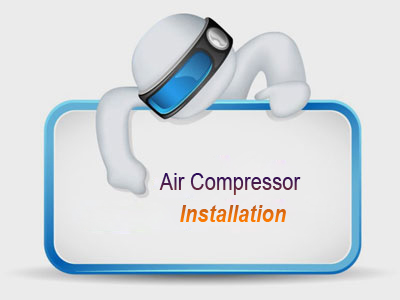
Tel : 0086 21 3783 1829
E-mail : info@denair.net

Tel : 0086 21 3783 1829
E-mail : info@denair.net
When installing a new air compressor, where you choose to install it can have a significant effect on its performance. A poor air compressor installation location can dramatically decrease efficiency and increase wear and tear leading to increased operating costs.

There are 4 key factors to consider when deciding where to install your air compressor:
1) Ventilation
One of the leading causes of unscheduled breakdowns is overheating. Because compressed air systems generate large amounts of heat they require effective ventilation.
When there is insufficient ventilation, heated air from the compressor exhaust re-circulates around the unit and is then re-inducted into the compressor increasing the operating temperature of the unit. This will cause the unit temperature to spiral upward and eventually shutdown.It is advisable to duct the air exhaust of a compressed air system to either an outdoor area or a heat recovery system.
Regardless of how you decide to duct the exhaust heat, addressing this issue at installation time can help extend the life of your compressor. Specifically, by exhausting the heat, you can lower operating temperatures increasing the life of your coolant, heat exchanger, bearings and hoses whilst lowering residual oil carryover.
2) Maintenance Access
It is important that the installation location allows for adequate maintenance access. Service Technicians need enough room to properly access the compressor to perform preventative and scheduled maintenance and more importantly for any future repairs requiring the removal of component parts within the compressor. If there is not adequate maintenance access than costs will increase as it will take more time and resources to complete service and repair work.
3) Shelter
An option for installation, in order to free up floor space in the plant, is to install compressors outside. If installed outside it is critical that the compressor has a purpose built, well ventilated shelter or enclosure to protect it from rain and UV light.
4) Environment
One common mistake that compressor installers make is that of checking the quality of the air that is drawn into the compressor. To get to know your environment, evaluate the size and make-up of air-borne particulates and ask yourself some questions regarding your surroundings:
• Is the compressor near a chemical process?
• Is chemical cleaning being done in the area?
• Is the compressor likely to ingest abrasive dust particles?
• Are noxious fumes present?
Most environments fall into one of three categories, dusty, hostile and clean. Here is a brief description and the potential problems:
Clean:
A clean environment is defined as having low dust and debris. This type of environment does not require much more beyond what would be considered standard maintenance.
Dusty:
Dusty conditions, on the other hand, may contain abrasive dust as well as dirt, casting sand, and other airborne particulates. The hazards created by these conditions can be reduced by using a high dust inlet filter. While it may not remove any additional particles, it can reduce frequency of replacement.
Hostile:
A hostile environment is defined as having caustic gases/chemicals, chlorine, ammonia, acids, in the air. With a hostile environment, one solution may be to remove the problem by relocating the compressed air system or the hazardous materials.
The best way to ensure you are installing an air compressor in an appropriate location is to consult with a compressed air expert when selecting a location to ensure your compressor runs at peak efficiency and reliability and keeps your operating costs to a minimum.
Related Information:

Privacy Policy © 2006 Denair Energy Saving Technology (Shanghai) PLC.